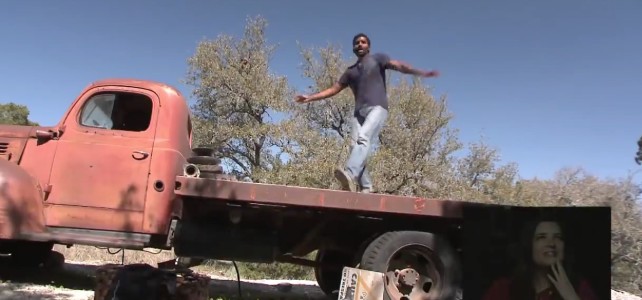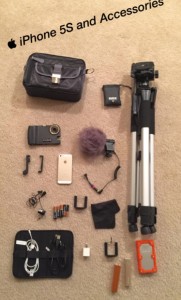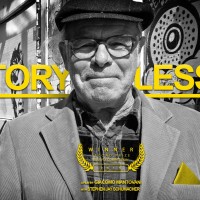There’s lots of evidence that mobile moviemaking is trending. This year at Sundance the mobile-shot feature “Tangerine” won acclaim…and a distribution deal. Meanwhile, around the world professional news crews are increasingly using smartphones. Less noticed, but still significant is the use of mobiles to shoot sponsored videos such as commercials, instructional videos, and promotional videos.
An example of this trend is Dhara Visual, a production company located in Texas. The company’s founder Prakash Gandhi Natarajan takes us behind the scenes of his video enterprise.
MMM: How did you develop your filmmaking skills?
Gandhi: Well, I never went to film school. After earning an engineering degree in India, I was recruited by a technology company–Cognizant–where I’ve worked for almost 12 years as a software engineer. I moved to the United States in 2005, and am still working for Cognizant. But all the time, I have loved to dance and have wanted to act in movies. So when I planned to propose to my wife, I hired a video production company and made a music video of myself dancing and proposing to my then girlfriend, who was totally surprised when she saw it at a local movie theater. That project reinforced my interest in movies and led me into filmmaking.
Frame from Gandhi’s proposal video. The insert is his girlfriend watching Gandhi’s performance.
MMM: That explains why you make movies. But how did you master the skills?
Gandhi: I am learning about filmmaking every day. I have a ton of bookmarks on Facebook regarding apps and gear. I regularly watch iOs videos made by different filmmakers from all over the world and try to understand how they did a particular shot. Of course, I also study independent movies and big blockbusters. I’m a fan of good storytellers.
MMM: Can you name a few films that have influenced you?
Gandhi: I really like “Trust” by David Schwimmer, “Safety Not Guaranteed” by Colin Trevorrow, “Blue Ruin” by Jeremy Saulnier, “We are What We Are” by JimMickle, and “Frozen” by Adam Green.
MMM: Do you use only mobile devices in your filmmaker-for-hire work?
Gandhi: Yes, just iPhones (iPhone 6 Plus, iPhone 5S) and sometimes GoPro Hero 3+ as the backup camera.
MMM: What are the advantages of using a mobile device rather than a traditional camera?
Gandhi: When you film a small business without trained actors, people tend to be shy in front of a professional camera such as DSLR and they don’t express what they want to say. But the same people take pictures and videos on their iPhone almost every day. So when I put an iPhone in front of them, they’re quite natural.
MMM: Anything other pluses for the mobile?
Gandhi: Setting up a DSLR takes time. But with an iPhone I can just walk in and start shooting. And using the iPhone doesn’t cost you a lot of money from the equipment side of things, which means I can charge a business less.
MMM: How do your clients react when they learn that you shoot with a mobile?
Gandhi: They’re always skeptical when I mention that I’ll be using an iPhone. But when they see my previous work, they’re persuaded that I can get a professional-looking video on an iPhone. When the final product turns out very well, they’re impressed and happy to refer to me to some one else.
MMM: Is that the main way you get business?
Gandhi: Yes, primarily word of mouth. But also, when I shoot an event,people see me running around with the iPhone taking videos and they want to talk about what I am doing. They then may ask for my contact information.
MMM: What about problems during a shoot?
Gandhi: There are always problems. For example, in making the promotional video for the dance studio, I was filming a rehearsal, and it included spontaneous moves that were not choreographed. I had to be ready to capture everything and there wasn’t time to change gear. That’s where iPhone comes handy. In most cases using the basic phone works perfectly, especially if there’s only one location.
MMM: Can you talk about a more complex shoot?
Gandhi: I shot a wedding by myself. It was challenging as I have to get all the possible shots. To make it possible, I used a second iPhone and a GoPro Hero3 +, setting these auxiliary cameras on tripods covering things like the dance floor. In between primary shooting, I’d run around starting and stopping these camera. While I couldn’t capture everything, I got a lot of useful footage. Getting good audio was also difficult. I was able to capture good audio from the minister by adding a Rode Smart Lav+ microphone on his shirt.
MMM: You did a promotional piece on the Ikan Fly x3 stabilization device. Can you give us your thoughts on that gear?
Gandhi: Ikan Fly x3 plus is a must in every iPhonegrapher video kits. I was able to achieve smooth shots around the dancers in “Dance Promo Video”. It would have been very shaky and unusable footage without it.
MMM: How did you learn to use the iKan?
Gandhi: An online tutorial taught me everything I needed about setting it up and using it.
MMM: I see that you edit sometimes edit using Final Cut Pro X and sometimes Adobe Premier Clip. Do you have a favorite editing app or does it depend on the project?
Gandhi: I am always trying out different apps every day. My favorite is the one on desktop which is Final Cut Pro X on my iMac since I can export different resolutions depending on the nature of the project. My favorite on the mobile is iMovie. I used Adobe Premiere clip since I was producing projects for their Ikan Fly Smartphone contest, It was mandatory to use Adobe Premiere Clip app. For color grading on the mobile, Movie Looks is a good app even though it produces somewhat lower quality video as the output.
MMM: Are there are other pieces of equipment or apps that you’d recommend to people just beginning to make mobile-shot movies?
Gandhi: For a beginner, just your iPhone, a tripod, and the stock camera app which comes with it, which is more than enough. I just used stock camera for the “Michelle’s Patisserie Promo Video. Once you are comfortable, then start using add-on lenses, external microphones, and other gear. Here’s a photo of my iPhone 5S kit.
Apps that I find useful are:
- Hyperlapse: time-lapse app
- Vee for Video: editing app
- FiLMiC Pro: camera app
- Movie Pro: camera app
- UltraKam: camera app
- 8 MM: old-fashioned movie-making app
- Vizzywig 8 HD: video editor and production studio
MMM: Do you have any advice for beginning mobile moviemakers?
Gandhi: Start shooting now. Shoot a video of yourself or your family doing chores around the house. When you go to a birthday party for your friend, shoot videos. When you have access to a computer, organize all the footage and try to compose a complete video that tells a story. Your first video may be very bad. But your tenth video will probably be awesome and your twentieth video will be official selection for a film festival. Like any other art, the only way to improve is to practice. You master videography by shooting videos very often.
MMM: How important are film festivals?
Gandhi: Film festivals are the best way to network with other film makers and also to showcase your work on big screen to the world. I am proud to say that my films have been official selections at The Global Compost Contest 2015, 5th Silguri International Short Film and documentary contest 2015, Miniature Film Festival 2015, Original iPhone Film Festival 2014, and International Mobil Film Festival 2015 (pictured below).
MMM: Can you give us a hint about your next movie project?
Gandhi: I have been writing short stories for a while. I can’t wait to produce and shoot short fiction films. I’m a one man shooter which means I will be shooting and editing my video by myself. That gives the challenge of getting good audio. In traditional filmmaking there’s usually a dedicated person assigned to carry a boom mic. Once I find a way to overcome that obstacle, then you will see short fictional films from me. For now, I will be shooting weddings, documentaries, events and shows. I’ve been travelling a lot and will soon release travel shorts films featuring Atlanta, San Diego, and Colorado.
MMM: How can readers keep up with your work? Do you want them to follow you on Twitter, Facebook, etc.?
Gandhi: Would love to have the readers follow my work. For those living in the real world, you can find me in Austin, Texas, United States. Here’s how to meet me online:
- Gmail : dharavisual@gmail.com
- Facebook : https://www.facebook.com/dharavisual
- Twitter : https://twitter.com/dharavisual
- Vimeo : https://vimeo.com/dharavisual/videos
- Instagram : https://instagram.com/dharavisual/
- Vine : https://vine.co/u/1206424673957847040
- Google+ : https://plus.google.com/105622016477039746184/posts






 Previous post
Previous post
 Next post
Next post






Why don’t you just buy a video camera.? If you want to do video production
Morgan–I can’t answer for Prakash, but I will give you my answer as the cofounder of MobileMovieMaking magazine and a filmmaker myself.
There is nothing wrong with buying a traditional video camera. I have one. I even own a 16 mm camera. Ultimately, though, what matters most is the quality of the filmmaking: developing a concept, finding talent, location scouting–and other such activities which are mostly the same whatever gear a person is using.
On this site, we focus on movies shot using mobile cameras–found in smartphones and tablets–because many people already have such cameras. Hence, they don’t need to spend additional money on getting traditional cameras. Also, the gear for mobiles–lenses, stabilization devices, etc.–is relatively inexpensive and rapidly improving.
Let me know if this answers your question.